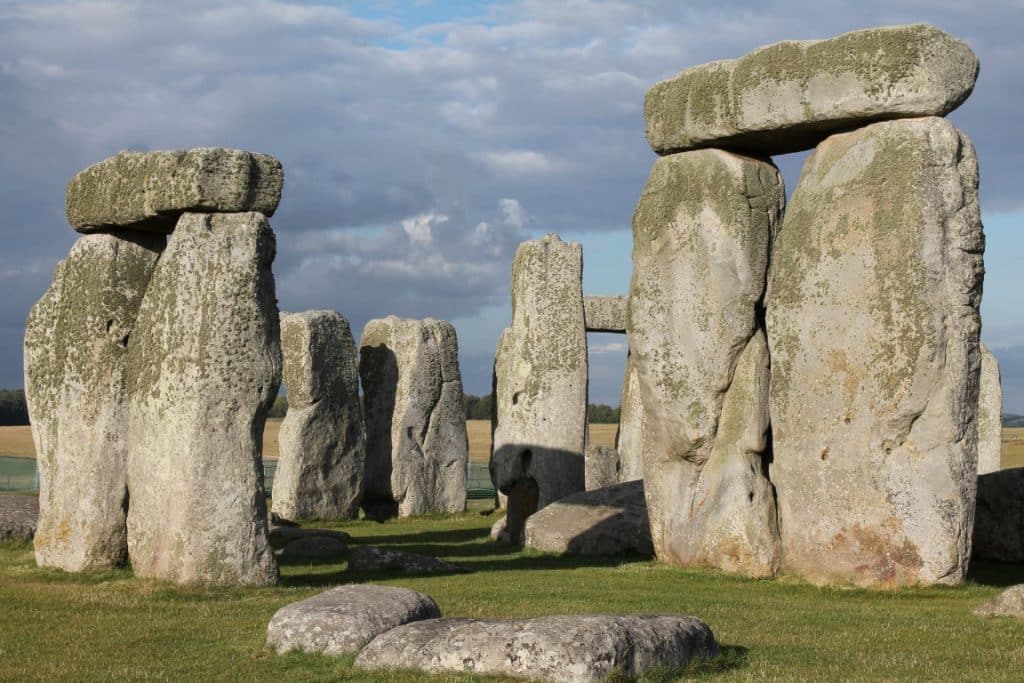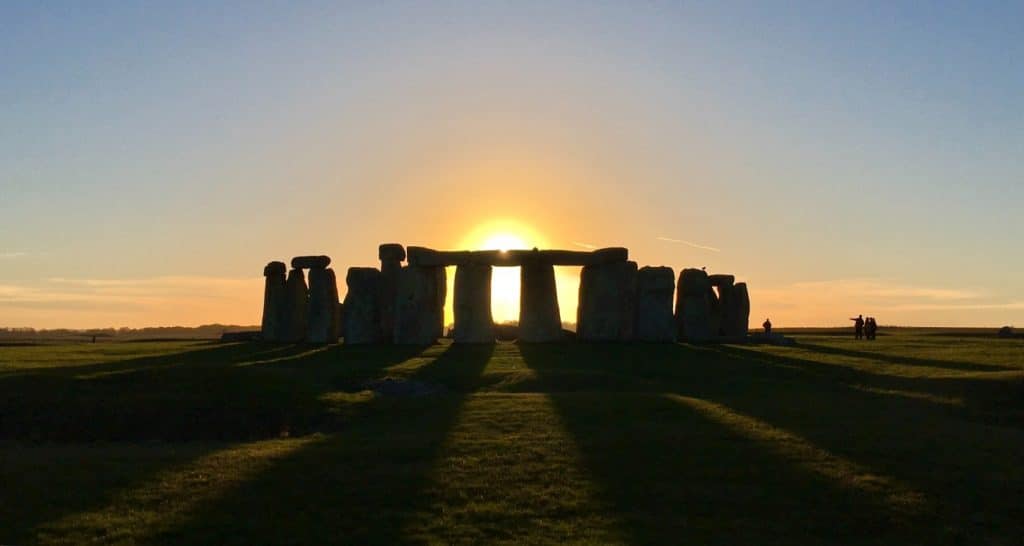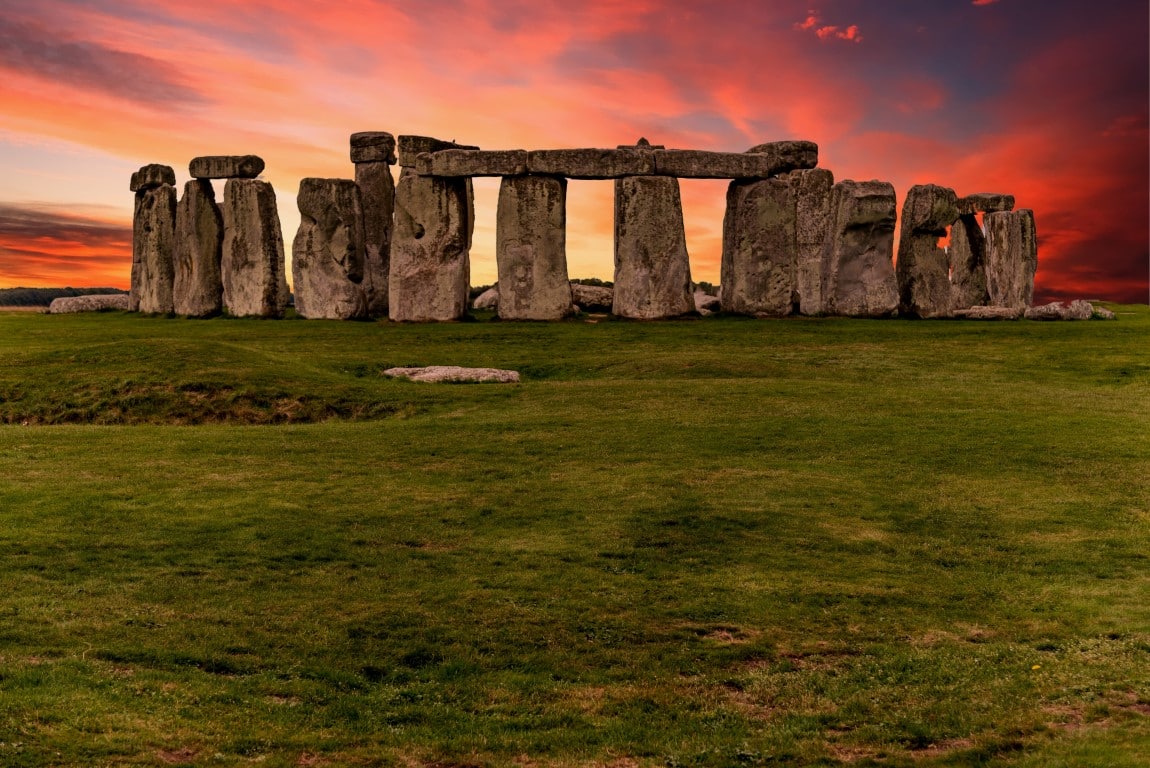Last Updated on 22/01/2024 by Alex Hamlyn
Table of Contents
Where is Stonehenge?
Introduction to Stonehenge
Stonehenge is an ancient site and prehistoric monument located in Wiltshire, England and is considered one of the most famous and mysterious landmarks in the world. It is comprised of a ring of standing stones, each weighing several tons and standing up to 4 meters tall.
The word “henge” is a term used to describe a type of ancient monument that is characterized by a circular arrangement of stones or megaliths. A henge monument typically consists of a circular ditch, an external bank, and a circular arrangement of stones or megaliths. The purpose of henges is not well understood, but they are believed to have been used for a variety of purposes, including astronomical observations, religious rituals, and as gathering places for communities. These structures often, but not always, include various internal features like stone or timber circles, altars, and burial pits.
The term “henge” is believed to come from the word “henge,” which appears in some Old English sources and is thought to be related to the word “hang,” as in something hanging or suspended. This might refer to the hanging of items in the henge or possibly the suspended state of the earthwork between the bank and ditch. It is not specifically derived from a word meaning “hinge,” and it does not directly refer to the circular shape of the monument.
Stonehenge is the most famous example of a henge in England, and it is one of the best-known and most recognizable prehistoric monuments in the world. Ironically it is not a true henge by the strictest definition, as its ditch lies outside its bank. This distinction is a common source of confusion, as Stonehenge is circular and includes stone circles, but its earthwork arrangement does not fit the technical definition of a henge.
Despite its age and significance, the true purpose of the monument remains a mystery, with several theories suggesting that it was used as a religious temple, an astronomical observatory, or a place of healing.
How and when was Stonehenge built?
The exact origin of Stonehenge and who built it remains one of the greatest mysteries of the ancient world. There is no written record of who built the monument or why, and the method used to transport the massive stones over such a great distance and how they were precisely placed is also unknown.
The stones are believed to have been placed in their current positions between 3000 and 2000 BCE, making the monument over 4000 years old. Stonehenge is widely recognized as one of the most important prehistoric structures in Europe and has been the subject of much study and research over the years.
Despite its popularity and the many theories surrounding its purpose, Stonehenge remains one of the most mysterious structures in the world. The method used to transport the massive stones from as far away as 150 miles, and how they were precisely placed, remains a mystery.
Theories about how Stonehenge was built have been a subject of much speculation and research over the years. Given the size and weight of the stones used in the monument, as well as the distance they were transported, it is clear that the construction of Stonehenge was a monumental task that would have required significant planning and organization.
One theory suggests that the stones were transported to the site using sledges, rollers, and boats. According to this theory, the stones were first dragged on sledges from the quarry to a nearby river, where they were loaded onto boats and floated down to the coast. From there, they were dragged on rollers to the site of Stonehenge.
Another theory proposes that the stones were transported over land using a system of ropes and rollers. According to this theory, a team of workers would have pulled the stones on sledges using ropes, with rollers placed under the sledges to reduce friction.
A third theory suggests that the stones were transported using a combination of water and land transportation, with the stones being floated along rivers and then dragged over land using ropes and rollers.
Despite the many theories, the exact method used to transport the stones to the site of Stonehenge remains unknown and the subject of much debate and research. Additionally, the methods used to lift the stones into place and arrange them in the circular formation are also the subject of much speculation and mystery.
The stones used in the construction of Stonehenge are quite large and weigh several tons each. The largest stones, known as sarsens, weigh up to 50 tons each and stand up to 4 meters (13 feet) tall. The smaller stones, known as bluestones, weigh between 2 and 4 tons each and are generally much shorter, standing at around 1 meter (3 feet) tall.
Despite their size and weight, the stones were placed with remarkable precision, forming a circular arrangement that is still standing over 4000 years later. The exact methods used to transport and place the stones are still unknown and the subject of much speculation and research.
The construction of Stonehenge is considered to be an impressive feat of engineering and a remarkable accomplishment of ancient technology. The fact that the stones were transported over long distances and placed with such precision is a testament to the ingenuity and determination of the people who built the monument.
Given the limited technology and resources available to the ancient builders, the construction of Stonehenge is seen as a remarkable accomplishment that demonstrates their advanced knowledge of engineering, mathematics, and astronomy. The fact that the monument has survived for over 4000 years and continues to stand as a testament to the ancient civilization that built it is also considered impressive.

Who built it?
Various theories have been proposed over the years, with some researchers suggesting that it was built by the ancient Druids as a religious temple, while others believe that it was a astronomical observatory used to track the movements of the sun and moon. Another theory suggests that it was a place of healing, where people would come to seek cure for their illnesses. Despite the many theories and speculations, the true purpose and builders of Stonehenge remain unknown and continue to be the subject of much research and study.
Is Stonehenge unique?
While Stonehenge is one of the most famous and well-known stone circles in the world, there are many other similar structures found around the world. Stone circles can be found in many parts of Europe, including Scotland, Ireland, and Scandinavia, as well as in other regions such as Africa, South America, and Asia.
However, connecting Stonehenge specifically to other stone circles around the world can be challenging. It is unlikely that ancient cultures this far from each other shared knowledge of religion, astronomy or engineering, but different ancient societies in different times and places have been able to make the same observations about the heavens and the seasons, and each has been inspired to build a monument or tool to what they have discovered.
Some of the other famous standing stone circles in the UK are;
- Avebury: A large stone circle located in Wiltshire, England, that comprises both standing stones and megaliths arranged in a circular formation.
- The Ring of Brodgar: A large stone circle located in the Orkney Islands, Scotland, that is larger than Stonehenge and comprises more stones.
- The Rollright Stones: A group of standing stones and stone circles located in Oxfordshire, England, that are believed to date back to the Neolithic period.
- The Long Meg and Her Daughters: A group of standing stones located in Cumbria, England, that form one of the largest stone circles in Britain.
Among these sites, Stonehenge is not even the largest stone circle, but it is one of the most well-known and recognizable. There are many other stone circles and megalithic structures found around the world, some of which are much larger than Stonehenge.
For example, the Ring of Brodgar in Scotland is a stone circle that is larger than Stonehenge and comprises more stones. The circle at Avebury in England is also larger than Stonehenge and comprises both standing stones and megaliths arranged in a circular formation.
These are some of the most famous and significant stone circles in the UK, and each one offers a unique glimpse into the history and culture of the ancient civilizations that built them. Whether you’re a historian, archaeologist, or simply someone interested in ancient cultures, these stone circles are well worth a visit.
Has what we learned about other stone circles helped us understand Stonehenge?
Studies of other stone circles around the world have certainly helped to provide a broader context for understanding Stonehenge and the significance of this type of monument. By comparing Stonehenge to similar structures in other regions, researchers have been able to identify similarities and differences, which can provide important clues about the purpose and meaning of the monument.
For example, studies of other stone circles in Britain and Ireland have shown that these structures were often used for rituals and ceremonies, which has led some researchers to conclude that Stonehenge may have served a similar purpose. Similarly, studies of stone circles in other parts of the world have revealed that these structures often align with celestial bodies, such as the sun and moon, which has led some researchers to conclude that Stonehenge may have been used as an astronomical observatory.
Some uncommon facts about Stonehenge
- Stonehenge was not always located in its current location: The stones that make up Stonehenge were transported from as far away as 150 miles, but the monument itself was not always located in its current position. It is believed that the stones were originally placed elsewhere and later moved to their current location.
- The stones were rearranged multiple times: Stonehenge was not built all at once, and the stones were rearranged multiple times over the centuries. The current arrangement of the stones is believed to be the result of several stages of construction and reconstruction.
- The stones were not all the same color: The stones used in the construction of Stonehenge were not all the same color. The sarsens, the larger stones, are a pale gray color, while the bluestones, the smaller stones, are a distinctive blue-gray color.
- Stonehenge may have been a place of healing: One theory suggests that Stonehenge was a place of healing, where people would come to seek cure for their illnesses. According to this theory, the stones were believed to have healing properties, and people would come to the monument to be cured of their ailments.
- Stonehenge was built using simple tools: Despite its size and complexity, Stonehenge was built using simple tools, such as antler picks and stone hammers. The fact that the ancient builders were able to construct such a complex structure using such basic tools is a testament to their ingenuity and determination.

What are the astronomical connections with Stonehenge?
Stonehenge has long been associated with astronomy, and many researchers believe that the monument was used to track the movements of the sun and moon. There are several astronomical connections that support this theory, including:
Alignment with the solstices
The solstices are two astronomical events that occur each year, marking the longest and shortest days of the year. The summer solstice, which occurs around June 20th or 21st, marks the longest day of the year, with the sun reaching its highest point in the sky. The winter solstice, which occurs around December 20th or 21st, marks the shortest day of the year, with the sun reaching its lowest point in the sky.
Stonehenge is aligned with the solstices, and the monument is designed so that the sun rises in alignment with one of the stones during the summer solstice and sets in alignment with another stone during the winter solstice. This alignment suggests that the ancient builders of Stonehenge were knowledgeable about astronomy and were using the monument to track the passage of the seasons and the movements of the sun.
In addition to its alignment with the solstices, Stonehenge also has astronomical connections with other celestial bodies, including the moon, which suggests that the monument was used for a variety of astronomical purposes.
Alignment with the moon
Stonehenge is also aligned with the moon, and researchers have found evidence that the monument was used to track the cycles of the moon and to predict eclipses.
Stonehenge is also believed to have astronomical connections with the moon. This alignment is suggested by the precise positioning of the stones, which researchers believe was used to track the cycles of the moon and to predict eclipses.
The moon has a 29.5 day cycle, during which it moves from full moon to full moon. This cycle was important to the ancient builders of Stonehenge, as it provided a means of measuring time and predicting eclipses. By aligning the stones with the moon, the ancient builders were able to accurately track its movements and use this information for astronomical purposes.
The exact nature of the alignment between Stonehenge and the moon is still the subject of much debate and research, but the evidence suggests that the monument was an important astronomical observatory used by the ancient builders to track the movements of the celestial bodies.
The alignment of Stonehenge with the moon provides important evidence of the monument’s astronomical significance and the advanced knowledge of astronomy held by the ancient civilization that built it.
Is there a connection between Stonehenge and Ley Lines?
Ley lines are lines that are believed to connect various ancient monuments, such as stone circles, standing stones, and other megaliths, across the landscape. Some people believe that ley lines have mystical or spiritual significance and that they were used by ancient peoples for religious or ceremonial purposes.
While there is no scientific evidence to support the existence of ley lines, some researchers have suggested that there may be a connection between ley lines and ancient astronomical knowledge. For example, some researchers have proposed that ley lines may align with important astronomical events, such as the solstices, and that they were used by ancient peoples to track the movements of the sun and other celestial bodies.
This theory remains controversial and has not been widely accepted by the scientific community. The existence of ley lines is still the subject of much debate and speculation, and there is limited scientific evidence to support the idea that they have any astronomical or spiritual significance.
Can I visit Stonehenge?
Stonehenge is open to visitors today, and thousands of people visit the site every year to admire its beauty and learn about its history.
Stonehenge is located in Wiltshire, England, and is easily accessible by car or public transportation. Stonehenge is approximately 90 miles (145 kilometers) west of London, England. The journey from London to Stonehenge by car takes about 2 hours, depending on traffic conditions. Alternatively, visitors can take public transportation, such as a train from London to Salisbury and then a bus to Stonehenge, which takes approximately 2.5 to 3 hours.
Visitors to Stonehenge can walk around the monument, admire the stones up close, and learn about its history and significance through the various exhibits and displays on site. Guided tours are also available, providing visitors with a deeper understanding of the monument and its place in history.
Stonehenge is a protected archaeological site, and a Scheduled Ancient Monument. It should not be surprising that there are some restrictions in place to help preserve the monument for future generations. Visitors are not allowed to touch the stones or walk among them, and there are designated paths that must be followed to help protect the site.
Conclusion
Stonehenge is a fascinating and mysterious ancient landmark that has captured the imagination of people for centuries.
Despite the many theories about its origin and purpose, the true meaning behind this ancient structure remains unknown. One thing we can be sure of is the skill, intelligence and logistical mastery of the people who built it.
The people who built Stonehenge may be gone, but they were able to organise, design, mine, transport and construct one of the most enduring ancient monuments in all the world.
Image credits
- Stonehenge at sunset: Photo by John Nail: https://www.pexels.com/photo/stonehenge-england-1448136/
- Stonehenge sunrise Photo by B A Fields : https://www.pexels.com/photo/silhouette-of-rock-formation-under-the-blue-sky-13017779/
- Stonehenge close up under clouds Photo by Kris Schulze: https://www.pexels.com/photo/stonehenge-under-dark-clouds-162056/
References
- https://en.wikipedia.org/wiki/Stonehenge
- https://whc.unesco.org/en/list/373/
- https://www.english-heritage.org.uk/visit/places/stonehenge/
- https://www.nationalgeographic.com/history/article/stonehenge-1

